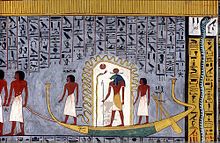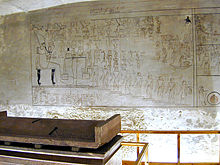Book of Gates
[2] It narrates the passage of a newly deceased soul into the next world journeying with the sun god, Ra, through the underworld during the hours of the night towards his resurrection.
It was named by French Egyptologist Gaston Maspero who called it 'Livre des Portes' (Book of Gates).
Many scholars have studied, deciphered, and translated the book from Jean-Francois Champollion to Erik Hornung and Alexander Piankoff, the latter two being the ones to create the designation of hours and divisions, respectively.
This was significant because it broke the traditional use of the Amduat usually displayed on walls of burial chambers prior to Horemheb.
It accompanies the Book of Gates in many tombs because it is a guide to the deceased's souls journey and the deities it will encounter in the Underworld.
It is believed the books are both often depicted in tombs because on their own, they are not a sufficient guide for the soul to complete its journey with Ra.
The gods that make up the crew of the solar barque are different between the Amduat and the Book of Gates.
In the Amduat, the solar barque is larger, whereas in Book of Gates, the crew is made up of only Heka and Sia.
The Book of Gates is a series of one hundred images broken into three registers for each hour depicting the journey.
[7][6] At the end of each hour, the deceased soul encounters a ‘gate’ guarded by a serpent deity that they must know the names and characteristics of in order to pass through unharmed.
Hour 1: This is Ra's arrival into the underworld and greeted by the “gods of the west” which refers to the Western Horizon.
There are also images of standards, one with a jackal head and one with a ram, held by bearded gods Set and Tat.
[7][6][10] Hour 3: Just beyond the door, named Piercing of Embers,” are twelve mummies who are protected by a fire-breathing snake at the front and back of the corridor.
The accompanying texts states Ra asks for safe passage across the lake of fire for the worthy blessed souls.
In front of this shine house are two groups of six goddesses guarding a hill to land, on the left, and one to water, on the right, separated by a giant serpent.
In the next sequence of the scene Horus is depicted presiding over the men the four ethnicities of man: Egyptian, Asiatics, Nubian, Libyans (sixteen in total).
In this scene Ra comes before twelve men who carry ma ’at feathers depicting they have been judged to be true and good.
It is also depicted that those that were judged to be evil are tied to jackal-headed stakes of Geb, awaiting their punishment.
[7][16] Hour 9: Ra passes through the gateway guarded by “Flaming of Face.” The doorway itself is named “Glowing One.” Passed the door Ra comes to an Island of fire and the Waters of Nun which has people floating in it, they will be restored and given breathe when they emerge.
At the end of the scene, Apep is captured by the gods standing before the solar barque, holding nets.
In this hour, is also a reconciliation between Horus and Seth which symbolizes the uniting of Upper and Lower Egypt under the sun god as begins to rise over the lands and bring a new day.
The writing by the scepters speaks praise of Ra and tells of his soul and body in heaven and earth, respectively.
At the beginning of the lower register are sixteen figures in repetitive sets of four being led by Horus into the afterworld.
The four beings correspond to the four ethnicities people were categorized in: Egyptians (Remetu), Asiatics (Aamu), Nubians (Nehsey), Libyans (Themehu).
Additionally at these two tombs, Seti and Merenptah, a Libyan is at the end of the row, at the 4th position and is depicted with typical Libyan features of the period, a side lock of hair and a long gown-like garment that is worn somewhat openly and with one or both shoulders exposed.








